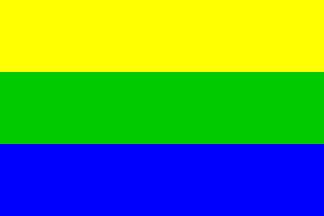 image by Ivan Sache, 07 September 2014
image by Ivan Sache, 07 September 2014
Last modified: 2025-01-11 by daniel rentería
Keywords: education |
Links: FOTW homepage |
search |
disclaimer and copyright |
write us |
mirrors
See Also:
 image by Ivan Sache, 07 September 2014
image by Ivan Sache, 07 September 2014
Institución Educativa Damasco is located in Santa Bárbara (Antioquia
Department).
The symbols of the institute, designed by Nlxon Gustavo Rodríguez Maturana, were
adopted on 5 May 1998.
The flag is horizontally divided yellow-green-blue. Yellow is the color of mango,
a main source of export and fame for the region. Green is the colour of the
exuberant natural environment of the mountains that surround the town.
Blue is the colour of the sky and of the river that waters the municipality.
Source:
http://romangquimico.webnode.es/inventos/escudo-y-bandera-i-e-damasco-santa-barbara-antioquia-/
- Nlxon Gustavo Rodríguez Maturana's blog
Ivan Sache, 07 September 2014
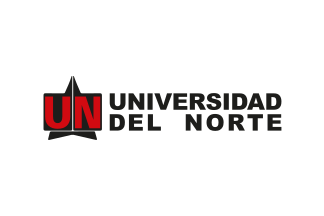 image by Tomislav Todorovic, 13 August 2023; based on photo
image by Tomislav Todorovic, 13 August 2023; based on photo
The "Universidad del Norte" (English: University of the North) was
established on January 24, 1966 in Barranquilla starting classes on
July 11, 1966.
Source:
https://www.uninorte.edu.co/web/sobre-nosotros/nuestra-historia
The flag is a white horizontal background with the logo in the middle, the logo being the letters UN (initials) in red, over a compass arrow in black pointing North and the University's name in Arial Black typeface.
The colors are:
"Rojo Uninorte" (English: Uninorth Red) C 0 M 100 Y 100 K 10 ; R 209 G
10 B 17 ; Pantone 1797C
"Negro Uninorte" (English: Uninorth Black) C 0 M 0 Y 0 K 100 ; R 29 G
29 B 27 ; Pantone Process Black
"Blanco Uninorte" (English: Uninorth White): C 0 M 0 Y 0 K 0 ; R 255 G
255 B 255 ; Pantone C
Source: "Manual de Identidad Corporativa 2022" (English: Corporate
Identity Manual 2022):
https://www.uninorte.edu.co/web/comunicaciones/portal-creativo
Esteban Rivera, 10 August 2023
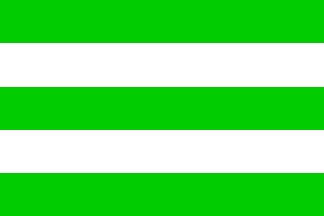 image by Ivan Sache, 9 June 2001
image by Ivan Sache, 9 June 2001
Colegio Nacional Deogracias Cardona - 2:3 flag with five
horizontal stripes green-white-greeen-white-green. Flag shown on
<www.deogracias.edu.co>,
located by Dov Gutterman.
Ivan Sache, 9 June 2001
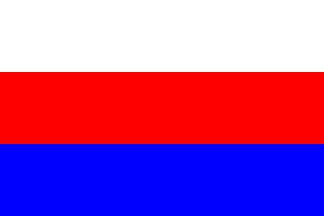 image by Ivan Sache, 19 October 2014
image by Ivan Sache, 19 October 2014
Liceo Departamental originates in the establishment of Liceo Femenino de
Bachillerato, separated on 23 December 1953 from the University of Valle in
Cali, and renamed Liceo Departamental Femenino in 1954. The institute was
nationalized in 1975. Institución Educativa Liceo Departamental was eventually
established by Municipal Resolution No. 1,744 of 3 September 2002, as the merger
of Liceo Departamental Femenino, Escuela La Gran Colombia (est. in 1939 as
Escuela de Niñas La Gran Colombia), and Escuela La Presentacion (est. on 7
December 1954 by the Sisters of the Presentation and placed in 1986 under
municipal administration).
The flag of the institute is horizontally divided white-red-blue.
Source:
http://www.liceodepartamental.edu.co/index.php?option=com_content&view=article&id=51&Itemid=93
- Institute's website
Ivan Sache, 19 October 2014
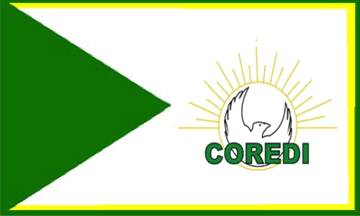 image by Ivan Sache, 04 September 2017
image by Ivan Sache, 04 September 2017
COREDI (Corporación Educativa para el Desarrollo Integral) has its
headquarters in Marinilla, Department of Antioquia, as well as several
branches in some 30 municipalities of the department. COREDI, founded
in 1992 and officially recognized in 1994, is part of the department's
strategy of rural education.
The flag of COREDI is white with a green (outside)-gold (inside)
border, a green triangle placed along the hoist and the institute's
emblem in the middle.
White represents progress and peace.
Green represents hope and future.
Yellow represents wealth and power.
The three colors symbolize the three pillars of the institute's
doctrina, organization, knowledge and production, respectively.
The
emblem of COREDI is made of a yellow sun illuminating the man's
progress and development, surrounding a white phoenix outlined in
black, recalling that COREDI was created after the refounding of the
village of El Peñol, relocated after the building of a man-made lake
that had flooded the old village, and the writing "COREDI" in green
letters.
A
photo of the flag, taken on 27 November 2009 during a street parade
held in the municipality of Argelia, confirms the design of the flag.
The ® mark shown on the emblem is omitted on the flag.
Ivan Sache, 27 July 2010
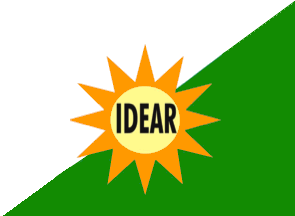 image by Ivan Sache, 25 January 2019
image by Ivan Sache, 25 January 2019
Instituto Técnico para el Desarollo Rural (IDEAR, Technical Institute for Rural Development), located in San Gil
(Santander Department), is managed by SEPAS (Secretariado Diocesano de
Pastoral Social), a body of the Diocese of El Socorro and San Gil.
The
flag of IDEAR is diagonally divided white-green from the lower hoist to the
upper fly. White represents peace built in the fields. Green represents
the floral diversity in the fields and the aspiration of the Santander
farmers to achieve better principles of life through education. The sun
in the center of the flag represents light that guides the quest for a
better life.
http://idearsangil.edu.co/nuestrainstitucion/#emblemas,
IDEAR website
Ivan Sache, 25 January 2019
Fundación Academia de Dibujo Profesional" (FADP) is
located in Cali. On 27 December 1978, by Decree No. 20717, the
Ministry of National Education approved the programs of
Advertising Design and Visual Communication, Architectural Design
and Decoration, and Textile Design and Industry. In 1980, the
Academy of Professional Design was transformed into a foundation
by Decree No. 080; the Academic Foundation for Professional
Design was recognized on 19 November 1984 (Decree No. 18638).
In 2006, the following programs were confirmed for the next seven
years: Graphic Design, Fashion Design, Multimedia Design,
Industrial Design, Architectural Design, Interior Design and
Advertising.
The flag of FADP, as shown graphically on the FADP
website, is white with the red emblem of FADP in the middle.
The "Manuel
de Imagen Corporativa", available on the FDP website,
contains the construction sheet of the logotype of FADP made of
six circular elements forming the initials of the institute (the
emblem) above the name of the institute. The red shade is
specified as CMYK 0 100 100 0.
Ivan Sache, 18 December 2008
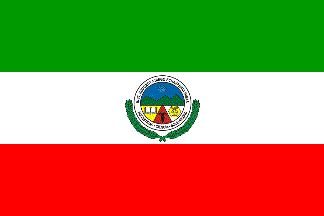 image by Ivan Sache, 7 July 2014
image by Ivan Sache, 7 July 2014
Institución Educativa Diego Echavarría Misas was established in
Florencia borough, part of the municipality of Medellín (Antioquia Department)
by Ordinance No. 18 of 28 December 1967, as Liceo Departamental Florencia. The
institute is named for the businessman and philanthropist Diego Echavarría Misas
(1895-1971), abducted and killed by the band led by "Mono Trejos".
The
flag of the institute is horizontally divided green-white-red with the
institute's emblem in the middle. The three stripes represent hope, peace, and
life, respectively.
The emblem of the institute is prescribed by
Resolution No. 3 of 1 October 1980. It features the sky, as a field open to
triumph and progress, charged with an atom, the symbol of science; mountains,
representing the Antioquia Department; a book, as the unique and supreme source
of knowledge; a Greek letter, representing the culture of all times; and a bee
and a honeycomb, representing the humans united by work in search of fraternity
and peace. The emblem is surrounded by branches of laurel representing triumph.
The institute's motto reads "Honesty - Science - Solidarity". Argent represents
innocence, whiteness and virginity. Or represents force, purity and constancy.
Vert (green) represents hope, abundance and liberty. Gules (red) represents
valor, audacity and intrepidness. Sable (black) represents prudence, sadness,
vigor, honesty, obedience, science and affliction. Azure (blue) represents
justice, zeal, truth, loyalty, charity, beauty, reality, majesty and serenity.
http://www.iediegoechavarriamisasmedellin.edu.co/index2.php?id=5269&idmenutipo=94&tag=col
- Institute's website
Photo:
http://www.iediegoechavarriamisasmedellin.edu.co/index2.php?id=5267&idmenutipo=94&tag=col
Ivan Sache, 7 July 2014
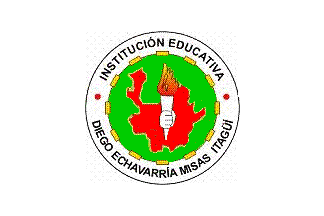 image by Ivan Sache, 7 July 2014
image by Ivan Sache, 7 July 2014
Institución Educativa Diego Echavarría Misas was established in Itagüí
(Antioquia Department) by Municipal Resolution No. 160,975 of 25 November 2002,
as the merger of Liceo Nocturno Raúl Guevara Castaño, Escuela Diego Echavarría
Misas and Escuela 20 de Julio. The institute is named for the businessman and
philanthropist Diego Echavarría Misas (1895-1971), abducted and killed by the
band led by "Mono Trejos".
The flag of the institute is white with the
institute's emblem in the middle. White is a symbol of integrity and
transparency.
The emblem of the institute, designed by Jesús Rúa Piña,
features the following elements:
- a red map of Antioquia Department, meaning
that many of our ancestors have offered their life and shed their blood to
establish a better world. Red is a symbol of life and high ideals of peace and
liberty;
- a green disk, symbolizing aspiration to obtain new and great
resources;
- a white fist, placed at the geographical location of Itagüí; it
also represents the union, purity and honesty of people;
- a torch, as a
symbol of socially-oriented, inextinguishable, physical activity;
- yellow
rectangles forming a kind of cog wheel, representing Antioquia as the main gold
producer in Colombia and Itagüí as a main industrial town.
http://www.iediegoemisas.edu.co/index2.php?id=212&idmenutipo=70&tag=col -
Institute's website
Ivan Sache, 7 July 2014
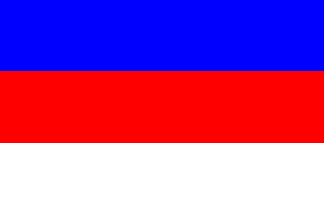 image by Ivan Sache, 13 March 2017
image by Ivan Sache, 13 March 2017
Institución Educativa Diego Fallón originates in a satellite of Colegio Francisco Nuñez Pedroso
(Mariquita, Tolima Department) established on 25 February 1975 in La Mina
sector, Frías village, Falan, Tolima Department.
Colegio Diego Fallón was established on 3 April 1994 by Municipal Decree No.
49.
Institución Educativa Diego Fallón was established on 9 November 2003
by Resolution No. 998 as the merger of 11 schools: Diego Fallón, Simón
Bolívar, Claras, La Playa, El Topacio, El Mango, Alto el Oso, Buenavista, El
Llano, La Noria, and Santa Rosa.
http://diegofallon.es.tl -
Institute's website
The institute is named for the romantic poet Diego
Fallón (1834-1905), whose works, the famous "La luna" (The Moon) included,
were compiled in the posthumous collection "Poesía" (1916).
http://www.biografiasyvidas.com/biografia/f/fallon.htm - Complete
biography
http://www.banrepcultural.org/blaavirtual/literatura/apoeta/apoeta49.htm
- "La luna", full text
The flag of the institute is horizontally divided
blue-red-white.
http://diegofallon.es.tl/ - Institute's website
Ivan Sache, 13 March 2017
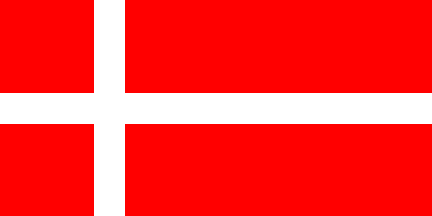 image by Ivan Sache, 06 September 2014
image by Ivan Sache, 06 September 2014
Institución Educativa Dinamarca ("Denmark") was established on 17 February
1971 in Medellín (Antioquia Department) by Jaime Ríos (Antioquia Department).
The flag of the institute is similar to the national flag of Denmark.
Source:
http://luzmarinaarismendy.galeon.com/ - Institute's unofficial blog
Photo:
http://0.static.wix.com/media/e890c7_7a19b9bb589a5ea899ebd9c32c4f7365.jpg_1024
Ivan Sache, 06 September 2014
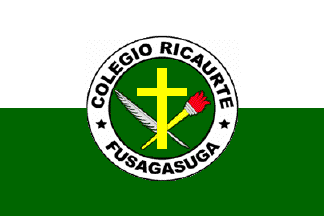 image by Ivan Sache, 10 November 2010
image by Ivan Sache, 10 November 2010
Fundación Educativa Colegio Diocesano Ricaurte de Fusagasugá was registered
by Episcopal Decree No. 337 (2006) and by Municipal Decree no. 471 (30 July
2007). Accordingly, the institute is a private catholic educational institute
belonging to the Diocese of Girardot. The institute is named for Captain Antonio
Ricaurte Lozano (1786-1814), a hero of the War of Colombian Independence.
Ricaurte died in San Mateo, Venezuela, while the institute is located in the San
Mateo borough of Fusagasugá (Department of Cundinamarca). The institute was
started in 1937, as Colegio Parroquial Ricaurte, by Father Manuel Vicente Rojas
Rincón.
The flag of Colegio Ricaurte, as shown on the institute's website, is
horizontally divided white-green with the emblem of the institute in the middle.
White represents virtue while green represents hope. Incidentally, but not
mentioned in the institute's website, the municipal flag of Fusagasugá is also
horizontally divided white-green.
The emblem of Colegio Ricaurte is a dark green disk charged with a yellow
Christian cross over a white quill and a yellow torch with red flame crossed per
saltire. The disk is surrounded by a white ring with the black writing "COLEGIO
RICAURTE" (top) / "FUSAGASUGA" (bottom), separated by two stars.
Source:
http://www.colegioricaurte.edu.co/institucional/quienes-somos.html?start=2
Ivan Sache, 10 November 2010
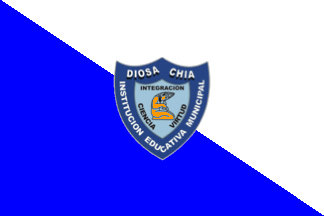 image by Ivan Sache, 28 July 2019
image by Ivan Sache, 28 July 2019
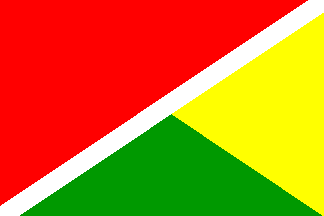 image by Ivan Sache, 27 October 2014
image by Ivan Sache, 27 October 2014
The flag of Escuela Normal Superior del Distrito de Baranquilla (Atlántico
Department) is diagonally divided by a white ascending diagonal stripe. The
upper triangle is red, while the lower triangle is divided yellow-green
according to the descending diagonal.
Source:
http://wwwescuelanormalbarranquilla.blogspot.fr/2009/08/somos-una-normal-superior-de-caracter.html
- Institute's blog
Ivan Sache, 27 October 2014
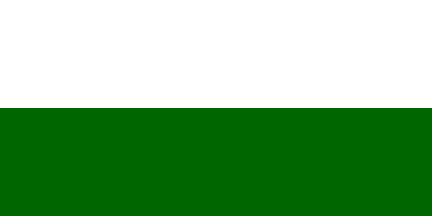 image by Ivan Sache, 16 August 2014
image by Ivan Sache, 16 August 2014
Colegio Divina Pastora was established on 4 February 1907 in Rioacha (La
Guajira Department) by His Grace Anastacio Vicente Soler y Royo.
The flag of the institute is horizontally divided white-green.
Source:
http://alvaroxthemusicologoo.blogspot.fr/ - Institute's unofficial blog
Ivan Sache, 16 August 2014
 image by Ivan Sache, 7 November 2010
image by Ivan Sache, 7 November 2010
Colegio del Divino Salvador, located in Suba (Bogotá Capital District), was
founded in February 1951 by the Sisters of the Divine Savior, aka Salvatorian
Sisters. The founders of the institute are the German-born missionaries Mothers
Bathilde Feder and Otilia Haeckel, sent to Colombia by the order's headquarters
located in Milwaukee (Wisconsin, USA).
The flag of Colegio del Divino Salvador, as shown graphically on the institute's
website, is horizontally divided blue-white. Blue stands for immensity and
aspiration to infinity. White stands for purity.
Source:
http://www.colegiodivinosalvador.edu.co/public_html/simbolos.htm
Ivan Sache, 7 November 2010
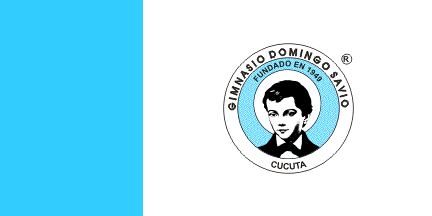 image by Ivan Sache, 22 June 2014
image by Ivan Sache, 22 June 2014
Gimnasio Domingo Savio was established in 1949 in Cúcuta (Norte de Santander
Department) by Helena and Sofía Cortés Gamboa. The institute is named for St.
Dominic Savio (1842-1857), an Italian student of St. John Bosco, canonized on 12
June 1954 by Pope Pius XII and proclaimed the patron saint of the schools
worldwide.
The flag of the institute is vertically divided white-blue (1:2), with the
institute's emblem in the middle of the white panel. Photos available on the
institute's website confirm that the flag in actual use is charged with the
emblem. Blue is a symbol of life, respect for the natural environment, hope and
tranquillity. White is a symbol of perfection, purity and peace.
The emblem is circular, a symbol of perfection. It features on a blue
background the image of Dominic Savio, in black and white, haloed
white. The emblem is inscribed with the name of the institute, its
year of establishment ("FUNDADO EN 1949" - established in 1949), and
its location ("CÚCUTA")
Source:
http://www.gimnasiodomingosavio.edu.co/web/index.php?option=com_content&view=article&id=59&Itemid=67 - Institute's website
Ivan Sache, 22 June 2014
 image by Daniel Rentería, 7 January 2024
image by Daniel Rentería, 7 January 2024
image from uninpahu.edu.co
The "Fundación Universitaria para el Desarrollo Humano, UNINPAHU" (English: University Foundation for Human Development) was created in 1974 in Bogotá.
Source: https://uninpahu.edu.co/quienes-somos/
The flag is a horizontal orange background with the new logo (all in
white) in the middle.
Esteban Rivera, 4 January 2024
1.jpg)
1.jpg) image from facebook.com and
image.isu.pub
image from facebook.com and
image.isu.pub
.jpg) image by Daniel Rentería, 7 January 2024
image by Daniel Rentería, 7 January 2024
image from issuu.com
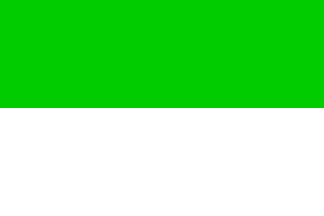 image by Ivan Sache, 8 November 2010
image by Ivan Sache, 8 November 2010
Centro Don Bosco (CDB), located in Bogotá, was founded on 11 April 1957 by
Salesian missionaries. The Salesians of Don Bosco (aka the Salesian Society),
founded by St. John Bosco (Giovanni Bosco, 1815-1888) in Turin on 26 January
1854 as the Society of St. Francis of Sales, was canonically approved by Pope
Pius IX in 1873. The third largest missionary organization in the world, the
Salesian Society has now more than 20,000 members. The Society is divided into
nine geographical Provinces and 94 four Vice-Provinces.
The flag of CDB, as shown graphically on the
institute's
website, is horizontally divided green-white. Green recalls hope placed in
the youth for salvation and creation of a new country. White represents
affirmation of life, values and good uses and the firm commitment to work for
the achievement of peace.
Ivan Sache, 8 November 2010
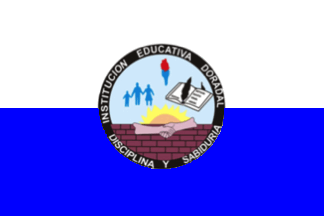 image by Ivan Sache, 22 August 2017
image by Ivan Sache, 22 August 2017
Instituci&oaucte;n Educativa Rural Doradal originates in the establishment in 1972
in Puerto Triunfo (Antioquia) of Escuela Integrada Doradal, officially
recognized on 10 March 1978 by Decree No. 354. Renamed as Concentración
Educativa Doradal on 11 June 1993 by Ordinance No. 16E, the institute was
eventually renamed as Institución Educativa Rural Doradal on 20 February 2003 by
Resolution No. 1,540.
http://www.ierdoradal.edu.co - Institute's website
The flag of
Institución Educativa Rural Doradal, designed in 1996 by the students María
Cecilia Martínez Solís and Geovany Tabares Arbeláez (8th grade), is horizontally
divided white-blue with the institute's coat of arms in the center. White is a
symbol of peace, while blue is a symbol of responsibility, firmness and honesty.
The coat of arms of Institución Educativa Rural Doradal was adopted on 9 May
1995 by the Board of Directors.
The torch represents sharing of free time and
active participation to sports.
The family highlights the orientation of the
school to family values.
The handshake represents the union of the teachers
and the parents for the improvement of education and the building of a better
future for the community.
The sun represents the emergence of the institute.
The quill and the book represent light that illuminates the way to wisdom.
The black ring surrounding the shield is inscribed with the institute's name
and motto, "Disciplina y Sabiduría" (Discipline and Knowledge).
http://www.ierdoradal.edu.co/index2.php?id=5853&idmenutipo=1071&tag=col -
Institute website
Ivan Sache, 22 August 2017
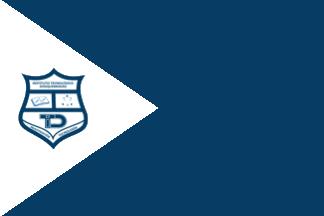 image by Ivan Sache, 27 November 2018
image by Ivan Sache, 27 November 2018
Instituto Técnico de Dosquebradas (Risaralda Department) was established in
1979 by Liliana Restrepo Arenas and Alfredo Hoyos Mazuera. The school's
management was transferred in 1995 to the Frisby Foundation.
http://itd.edu.co/
Institute website
The flag of Instituto Técnico de Dosquebradas is blue with a white triangle
placed along the hoist and charged with the school's coat of arms. King blue is
associated with marvelous dreams and deep aspirations; it represents an
invitation to consolidate our soul and heart to build a more human world. White
indicates that every moment is a new opportunity to clarify our commitment as
integral part of cosmos. It is the permanent quest for peace and pacific
coexistence, it is the clear, good side of people required to build a more happy
planet. Blue and white form a didactic trilogy with the coat of arms.
The
coat of arms features a book, as a beautiful evidence of human transcendence.
The book is inscribed "VALOR - CIENCIA" (Valor - Science), which means that the
human being shall create, with responsibility and ethic, to the profit of the
community's development and its perpetuation over generations. The triangle
represents the education's trilogy, expected to educate free and autonomous
people:
- trilogy of the living principle and education's rational (House -
School - Society);
- exemplar trilogy of the profile of a committed and
transcendent citizen (Student - Teachers - Parents);
- essential trilogy of
human development (To be - To know - To know how to be);
The superimposed
unfinished triangle represents the irrefutable manifestation of constant change,
of transmutation, of fictitious character of end results... Constant change
towards new and constructive. The figures that "devour" the superimposed
triangle represent eagerness to learn and scientific practice, which are
fundamental aspects of the profile of the human being in the new millennium.
http://itd.edu.co/institucional/#simbolos-y-emblemas-institucionales
Institute website
Ivan Sache, 27 November 2018
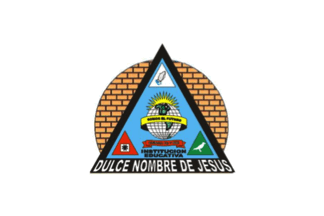 image by Ivan Sache, 02 September 2017
image by Ivan Sache, 02 September 2017
Institución Educativa Dulce Nombre de Jesús was established in Sincelejo
(Sucre) in 1993 by Municipal Agreement No. 2. Classes started on 25 January
1999. The institute is named (Jesus' Sweet Name) for the patron saint of
Sincelejo.
The flag pf I.E. Dulce Nombre de Jesús is white with the institute's emblem in
the center.
Source:
http://www.iedulcenombredejesus.com/quienes-somos.html - Institute's website
Ivan Sache, 02 September 2017